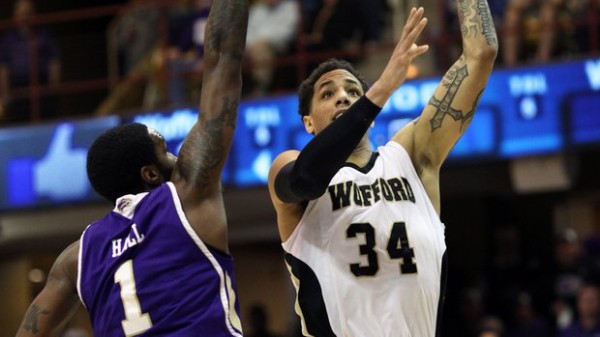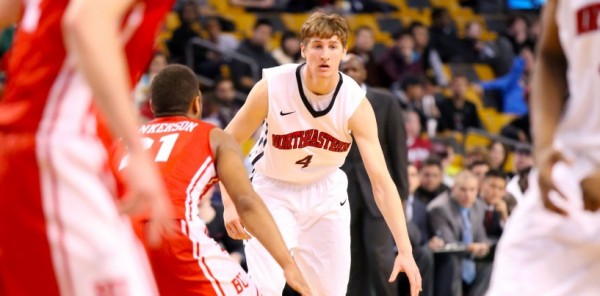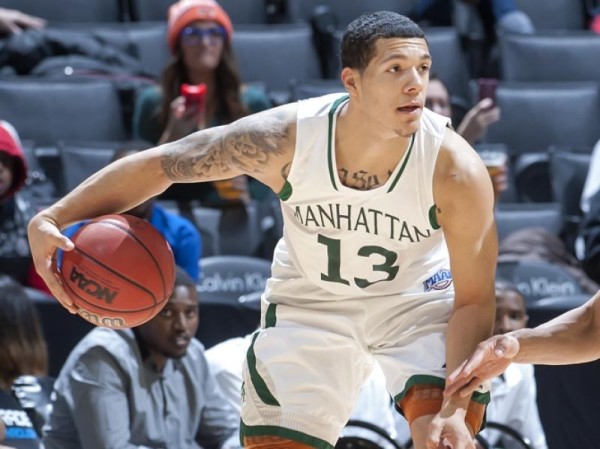Bracket Prep: Wofford, Northeastern & Manhattan
Posted by Tommy Lemoine on March 10th, 2015As we move through Championship Week, we’ll continue to bring you short reviews of each of the automatic qualifiers to help you fill out your bracket next week. Here’s what you need to know about the most recent bid winners
Wofford
- Southern Conference Champion (28-6, 16-2)
- RPI/Pomeroy/Sagarin = #48/#90/#86
- Adjusted Scoring Margin = +5.0
- Likely NCAA Seed: #12
Strength: Control is the name of the game for Wofford, on both sides of the ball. Offensively, the Terriers like to slow things down (19.1 seconds per possession) and look for the best shot, which often winds up in the hands of conference Player of the Year Karl Cochran; the guard takes more than one-third of his team’s shots when he is on the floor. The SoCon champs also do a great job of taking care of the ball, coughing it up just four times in their 55-54 upset over North Carolina State in December. Still, as steady as its offense can be, Wofford’s real bread and butter is on the defensive end where it holds opponents to just over 0.97 points per possession. The Terriers tend not to gamble in the full-court (in line with that whole ‘control’ idea), but they do like making life difficult on the perimeter – reflected in their 30.8 percent three-point defense (26th-best mark in college hoops).
Weakness: Wofford severely lacks size – ranking 329th nationally in effective height – and it shows against much bigger opponents. In its season opener against Stanford, the Terriers were single-handedly beaten by 6’11” big man Stefan Nastic, who scored 26 points on 11-of-14 shooting. It was a similar story in Cameron Indoor Stadium, where Duke’s Jahlil Okafor shot 11-of-14 and scored 24 points. Forwards Lee Skinner and C.J. Neumann are both good players, but their lack of height (6’6” and 6’7”, respectively) could become a liability against a much larger NCAA Tournament opponent.
Key Player: Karl Cochran (14.8 PPG, 5.8 RPG, 1.8 SPG). Cochran’s importance cannot be understated. He takes a huge percentage of his team’s shots – the majority of which come from the perimeter – and almost always has the ball late in the shot clock. The senior’s 38 percent mark from three-point land is all the more impressive when you consider that he’s attempted a whopping 249 of them. On top of his offensive impact, Cochran is an excellent rebounder for a guy his size (6’2”) and one of the best perimeter defenders at the mid-major (if not national) level. Steady-handed, well-rounded and experienced, he is the exact type of guard you want leading your team in March.
Outlook: Wofford can certainly play with high-major opponents (just ask the Wolfpack), but its NCAA Tournament success may come down to the matchup. If the Terriers draw someone with great length and athleticism or a dominant post presence, they might be in trouble. If they draw a jump-shooting team – one that doesn’t have great size – an upset is possible.
Northeastern
- Colonial Athletic Champion (23-11, 12-6)
- RPI/Pomeroy/Sagarin = #95/#117/#125
- Adjusted Scoring Margin = +2.6
- Likely NCAA Seed: #15
Strength: Northeastern is very well balanced, with all five starters averaging between eight and 15 points per game and each adept at crashing the defensive glass. But their biggest strength (both literally and figuratively) is 6’8” big man Scott Eatheron (14.6 PPG, 6.4 RPG), who plays like a true center. His post skills combined with the Huskies’ vastly-improved outside shooting (up to 38.8% 3FG this season from 32.4% 3FG a year ago) creates a tough predicament for opposing defenses – either commit extra attention down low and risk being burned from the perimeter, or stretch out your defense and risk domination by Eatherton.
Weakness: Turnovers are a problem. The Huskies coughed it up at a 21.4 percent clip – one of the 50-worst marks in college hoops – and suffered at least 14 miscues in seven of their 11 losses this season. In a 25-point defeat at Massachusetts in November, they turned the ball over 20 times. Northeastern might be in big trouble if it bumps up against an aggressive defense next week. Additionally, the CAA champs have very little depth, as starters account for almost 80 percent of all minutes played. As a result, they are at a major disadvantage when relied-upon starters – especially Eatherton – approach foul trouble.
Key Player: Quincy Ford (10.1 PPG, 5.4 RPG). Eatherton may be Northeastern’s best and most important player, but Ford is something of an ‘X-factor’. His size (6’8”) and athleticism makes him an incredibly difficult matchup, especially with his ability to knock down perimeter shots (36% 3FG). William & Mary had no answer for the junior on Monday night (22 points on 8-of-10 FG) and he will have to play at a similarly-high level for the Huskies to compete next week.
Outlook: Northeastern is a well-rounded, workmanlike team that prevents second-chance opportunities and can beat you from multiple areas of the floor offensively. It’s hard to see the Huskies toppling a #2 seed, but it’s also hard to picture them being run off the floor.
Manhattan
- Metro Atlantic Champion (19-13, 13-7)
- RPI/Pomeroy/Sagarin = #179/#141/#168
- Adjusted Scoring Margin = +0.4
- Likely NCAA Seed: #15
Strength: Manhattan thrives on full-court pressure, forcing opponents to turn the ball over at a high rate, which in turn catalyzes its transition offense. When teams cross the timeline, the Jaspers are willing to gamble for run-out steals and do an good job of hounding perimeter shooters, which Iona learned the hard way on Monday night; the usually-red-hot Gaels shot just 5-of-22 from behind the arc. They also have a player – 6’6” senior Emmy Andujar – whose size and versatility presents considerable matchup problems. As a bona fide point-forward, his height and vision makes him extra proficient at locating teammates in transition.
Weakness: For as good as Manhattan is at forcing turnovers, it’s pretty terrible at holding onto the ball; the Jaspers’ turnover rate (21%) was worst in the MAAC. They also don’t shoot the ball particularly well from long-distance (34% 3FG), which becomes a problem for a team that attempts over 18 three-pointers per game. When they are unable to attack the lane (and draw fouls) and the outside shots are not falling, Manhattan has trouble scoring enough points to win.
Key Player: Emmy Andujar (16.5 PPG, 7.5 RPG, 3.5 APG, 2.1 SPG). The senior point-forward leads his team in points, rebounds, steals and assists, which is a pretty good indication of just how important he is to his team. Even Manhattan’s NCAA Tournament opponent might have trouble matching up with the 6’6” Andujar, whose versatility makes him one of the most unique players in the country.
Outlook: Just like last year, Manhattan knocked off regular season champion Iona and earned the automatic NCAA Tournament bid. This difference this time around, however, is that the MAAC championship ‘upset’ was truly an upset, and the Jaspers – with an RPI approaching #180 – will receive no higher than #15 seed. After nearly beating #4 seed Louisville in the round of 64 last season, expect no such result this March. Steve Masiello’s aggressive crew might have its moments, but it will probably be overmatched next week.












































